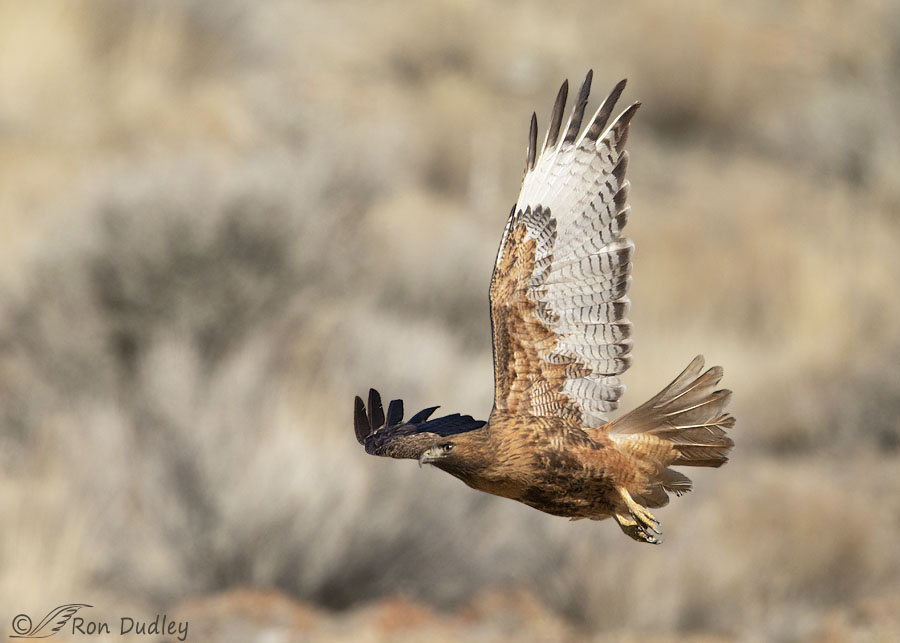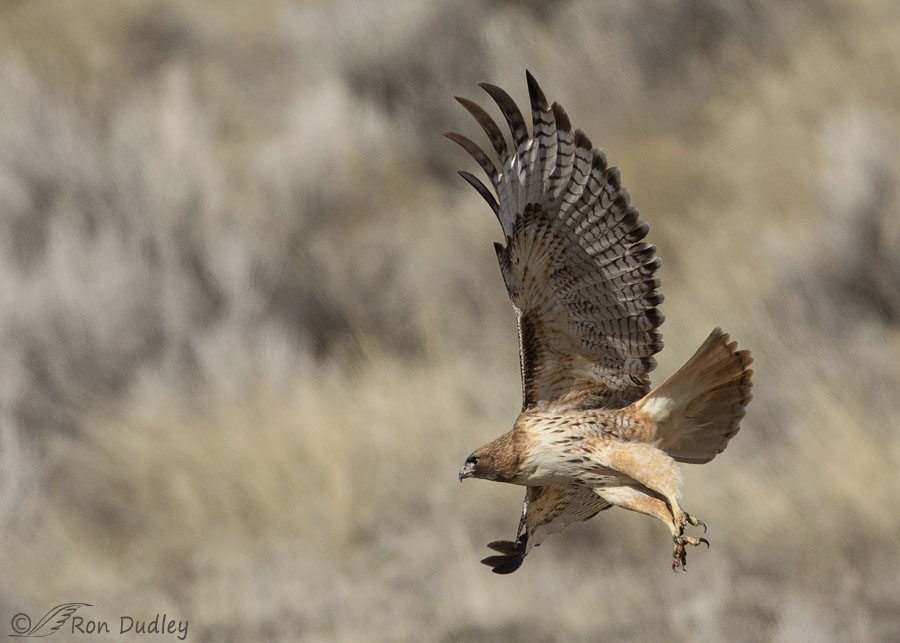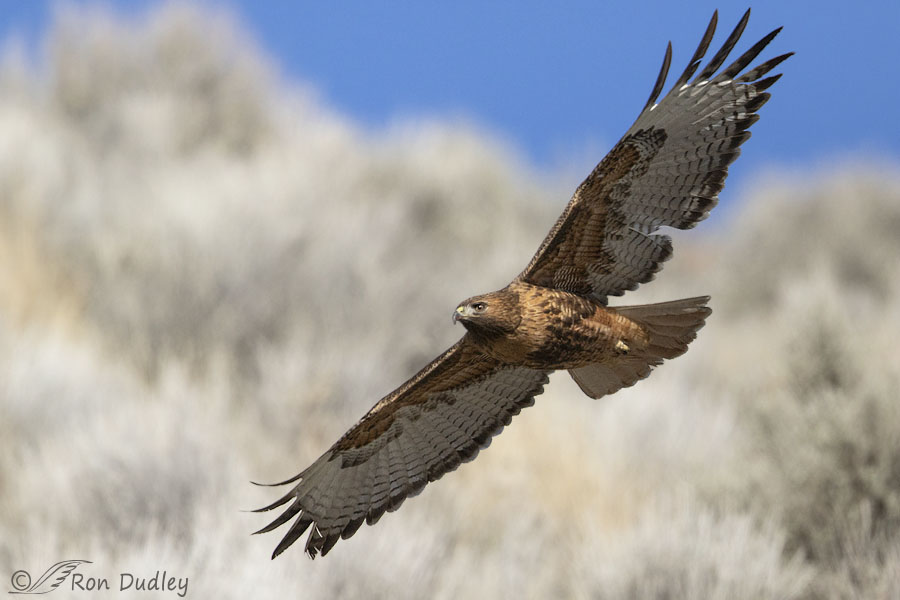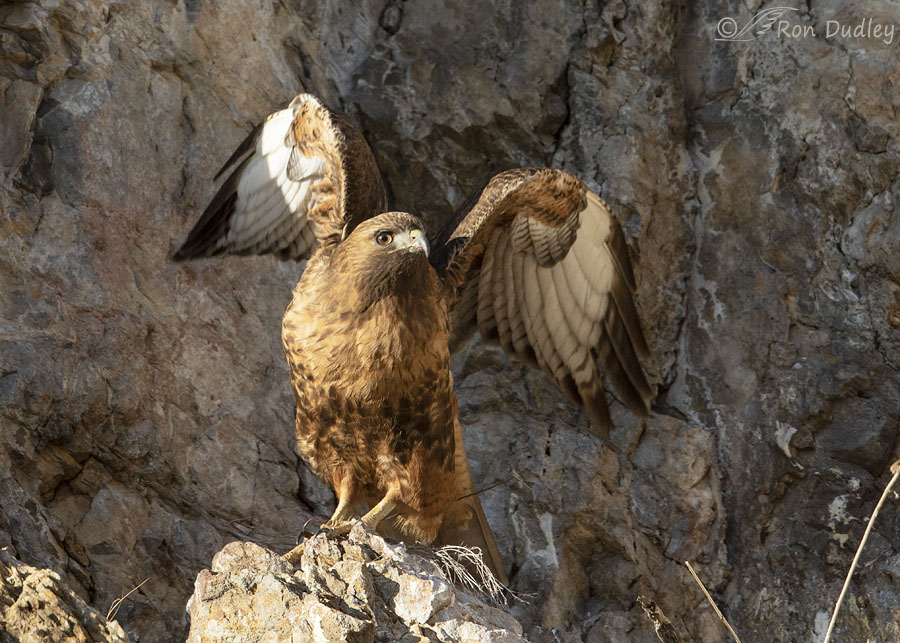More photos of the red beauty taken about 10 days ago. This time I’ll include a similar photo of her mate for the sake of comparison.

1/4000, f/6.3, ISO 640, Canon 7D Mark II, Canon EF 500mm f/4L IS II USM + EF 1.4 III Extender, not baited, set up or called in
As evidenced by her foot position and flared tail I got this shot soon after she took off. The angle of light and her flight posture highlight her stunning rufous body color. I believe she’s the reddest Red-tailed Hawk I’ve ever photographed.

1/5000, f/6.3, ISO 640, Canon 7D Mark II, Canon EF 500mm f/4L IS II USM + EF 1.4 III Extender, not baited, set up or called in
And this is her mate in a similar flight posture. The two photos back to back allow a good comparison between a fairly typical western light morph adult Red-tailed Hawk (the male) and the rufous female, an intermediate adult.
I didn’t get as many good photos of the male as I did of his mate and with his head turned away from me like it is this photo is an example. Part of the reason for that was my own fault. I was so enamored by the rufous female that I spent significantly less time with my lens trained on her mate.
1/1600, f/6.3, ISO 640, Canon 7D Mark II, Canon EF 500mm f/4L IS II USM + EF 1.4 III Extender, not baited, set up or called in
Here the female is about to take off from her perch on the side of a cliff. Once her wings were fully spread I cut them off in every shot – one of the obvious dangers of being too close to your subject for takeoff and flight shots.

1/6400, f/6.3, ISO 640, Canon 7D Mark II, Canon EF 500mm f/4L IS II USM + EF 1.4 III Extender, not baited, set up or called in
Here the female is in full flight as evidenced by her tucked feet but I was damned near too close for this one too. The photo is full frame (uncropped) but even so I had very little wiggle room for the tip of her left wing and not much more for her right one. I was lucky to keep all of her in frame.
Over the last few weeks I’ve nearly saturated Feathered Photography with photos of the rufous female but I suspect these images will be about the last of her for a while. She’s probably incubating by now and even though her mate will assist her in that chore much of her time will be spent on the nest so I’ll likely have few opportunities with her.
It was wonderful while it lasted.
Ron
PS – It snowed last night. So much for spring weather…



Spectacular series Ron! Thanks for sharing!
Charlotte
Thank you, Charlotte.
Beautiful birds, she is a attractive morph. I guess you did once say you liked redheads.
We finally have power again, we had a heavy 5-6 inches fall that took out the power, I could hear transformers blowing and arching. There are huge branches down and my friends giant pine tree fell over across her driveway.
I heard that parts of town lost power, April. Sorry you were included. We only had about an inch of snow here and it didn’t even stick to the roads.
Fantastic Photos!! What a spectacular bird. Thanks.
Thank you, Joanne.
Don’t imagine! 😉
🙂
What a striking couple! I don’t think I’d ever tire of seeing her or her mate. As I was reading today’s post, I wondered what the babies would look like and looking at the comments, I see I’m not alone. 🙂
Quite the birdpourri in the backyard this morning when I took mama dog out for her morning ablutions. Mourning Dove calling, Black Phoebe hanging out (both on telephone wires right above the yard), California Gulls flying overhead, at least two species of LBJs scuttling around by the orange trees (they’re using a couple of our bushes and the overgrown side yard as nesting areas), and part of the “university’s” parrot flock flying by and squabbling in my neighbor’s palm tree. And my neighbor’s chickens, clucking away. 🙂
Thanks, Marty. I’ve still never seen a Black Phoebe but apparently they’re pretty common in your area. All we get is Say’s Phoebes.
You’re more than welcome to visit! 🙂
I’m never put off by your choices even though they may become a series. The photos are beautiful and the information very welcome. I see so many things I do not have the opportunity to see in person.
I appreciate that, Betty.
I’ve been thoroughly enjoying the “saturation.” What a gorgeous bird!
I didn’t chime in on the horizontal vs. vertical discussion, because for me, both versions had good points and drawbacks, and I didn’t have a clear preference. The last shot in this post is, IMO, the best of all possible worlds – plenty of space to fly into; fully extended wings in that nifty diagonal position, filling enough of the frame to feel fairly close; pleasing background; and just enough bright blue sky to give me that soaring sense of freedom. Stunning. Thank you, thank you!
Thanks for chiming in on that discussion, Robyn – late is better than never.
Wow, spectacular images. I can see why you’re so enamored – she’s a beauty.
Thank you, Linda.
I wonder if there were other males in the female’s territory from which she chose this mate, or whether he was the only male available. They both seem to be large and healthy birds. Around here, there seem to be fewer redtails than in years past (and more red-shouldered hawks), and the color type is pretty uniformly dark. These are handsome birds and I wish them luck with their nesting.
Martha, this species typically mates for life (unless one bird dies) and this male looks just like her mate last year so I strongly suspect he’s the same bird.
Hi Ron,
Lovely female. I can understand your choice to follow her more than her mate. I guess it’g a guy thing.
Noticed something interesting about the perched female shot at take off. When I put my cursor over the image, on my Mac, a hand appeared and when clicked, the image reappears without the accompanying text provided. Its not a separate link to a new page, but simply a change in the view. I have never seen this on your site and allows me to save the image and then open in photoshop. I don’t know if this is your intent, but does allow someone if they are so inclined to ship your image. Just a heads up and again I have never seen this before on your site.
Cheers!
Thanks, Frank.
Some time ago I had to turn off the setting that prevented “right click save” (it’s right click on a pc) because of problems with that plugin. I’m not happy about it but I had no choice. Hopefully I’ll be able to use it again in the future.
She really is stunning. I loved seeing her mate. He’s no slouch. 😀
Thanks, Arwen. Nope, he sure isn’t.
Have to state the obvious: the male pales compared to the female. They are both beauties, though; makes one wonder what the coloration of the offspring will be. Wonderful complementary composition of bird and background in the third photo. Intriguing notch in the females left secondaries in the last shot.
“makes one wonder what the coloration of the offspring will be”
I’ve been wondering the same thing, Lyle. Hope I get to find out.
Ron, we will NEVER be tired of your photos of this spectacular RTH!! She is very special!!
Good! Thanks, Jo Ann.
Beautiful photos Ron. The third with her uplifted wings and her rufous colors against the rock background is perfect. Great shots all. Always envious of the in-flight photos. Judy has snow and we have pollen.
Everett Sanborn, Prescott AZ
Thank you, Everett.
I’ve been seeing quite a few photos of massive pollen dumps on Facebook. Just another kind of “yellow snow”…
The colors are more muted in the male with the breast being MUCH lighter – easy to see up close – at a distance more of a challenge. Thx for the comparison, Ron. The male is also a beautiful bird BUT! 😉 Love the 3rd photo with the female ready for take off! 🙂 Trying to snow here – most is going S of us – good news since things are trying to dry off BUT could use the moisture. Don’t think it’s done with us yet – Good Friday and Easter are always good times for “spring dumps” here! 😉
Thanks, Judy. Glad you enjoyed the comparison.
I’ve seen it snow so hard here in mid-May that it broke large tree branches all over the valley so I’m not surprised. Only a little disappointed…
BTW, my cousin Ken often said that he’d seen it snow every month of the year on the farm near Cut Bank.
I’ve seen it in July but can’t say “every month” BUT! Yes, those “spring dumps” can be hell on the landscaping! 🙁
On the 1st or 2nd of September in 1969 it snowed on our honeymoon just over the border in Alberta. That snow didn’t cool everything off though…